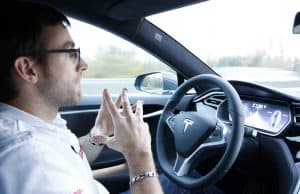Just this week, we filed suit against Ford Motor Company in Tucson Arizona on behalf of Border Patrol Agent Luis Pena and his family. Agent Pena was driving his Border Patrol F250 in response to a narcotics call when he went off the road, corrected and rolled over. During the rolls, the roof of the F250 collapsed completely on top of Agent Pena, rendering him a quadriplegic. Agent Pena’s case is the second one we have been forced to file in the last six months on behalf of active duty Border Patrol Agents. Previously, we filed suit against General Motors on behalf of Agent David Webb. Agent Webb died after the roof of his Border Patrol Issue Chevrolet Tahoe colappsed on top of him following a rollover. It’s a shame that those who protect us all receive no protection whatsoever in the vehicles they are forced to drive every day. In our lawsuit against Ford, we week punitive damages. Ford has known for years that roof crush causes catastrophic injury and death and yet has consistently refused to strengthen the roofs of its vehicles. What follows are the punitive damage allegations from the Pena family’s complaint:
EXEMPLARY DAMAGES
(FORD MOTOR COMPANY ONLY)
24. Plaintiff incorporates the allegations set forth in paragraphs 1-23 of the Complaint. Plaintiff further alleges, as to Defendant Ford Motor Company as follows:
25. The conduct of Ford Motor Company was done with fraud, malice and oppression, and with the willful and conscious disregard of Plaintiffs rights and safety and the rights and safety of others, thereby entitling the Plaintiffs to damages in an amount sufficient to punish or make an example of Ford Motor Company.
26. Furthermore, Ford Motor Company, through its officers, directors and/or managing agents, authorized, directed, conducted and ratified each of the following acts, and engaged in the following conduct:
In its “1965-66 Roof Collapse Evaluation” study, Ford conducted drop-testing on the roofs of a number of its vehicles to determine whether they would “incur[] subjectively unacceptable collapse” of the roof into the passenger compartment. “Subjectively unacceptable collapse” of the roofs was defined as encroachment of the roof “upon a 30” rod mounted vertically in the front occupant position with its end at the “H” point with seat full forward.” In other words, Ford recognized roof collapse that left less than 30 inches of “survival space” between the “H” point and the roof was “subjectively unacceptable.”
A second purpose of Ford’s “1965-66 Roof Collapse Evaluation” was to evaluate a roof crush criteria proposed by the SAE Automotive Safety Committee whereby vehicles dropped on their roof from a height of 2 feet would not demonstrate the “subjectively unacceptable” roof collapse defined above as encroachment of the roof to within 30 inches of the “H” point.
c. As part of the study, Ford dropped a number of its vehicles on their roofs from both 2 and 3 feet. Every vehicle demonstrated “subjectively unacceptable” roof collapse when dropped from heights of 2 and 3 feet.
In 1967, Ford did a “safety benefit/cost summary” in which it attempted to determine the cost of human lives and serious injuries versus the cost of improving its vehicles to prevent deaths and serious injuries. In that study, Ford concluded that “totally effective rollover protection cannot be easily justified if it costs more than $26 per car.”
By that time, Ford knew that the “incidence of roof impact [was] significant” in crashes involving its vehicles. Specifically, and as part of a 1968 roof strength study, Ford concluded that:
People are injured by roof collapse. The total number of nationwide deaths and injuries cannot be estimated but it is a significant number.
In other words, Ford knew, and at all times relevant to this lawsuit has known, that a “significant” portion of the vehicles that it sold to the consuming public would be involved in crashes where those cars rolled over or otherwise ended up on their roofs.
f. The same 1968 roof strength study confirms the “subjectively unacceptable” roof collapse criteria recognized in Ford’s 1965-66 Roof Collapse Evaluation and further recognizes that “roof intrusion to 29.4 inches above the ‘H’ point will not interfere with the “depressed head” space of 99% of vehicle occupants.”
g. The 1968 study also predicts that the use of 3-point seatbelts will increase, leaving occupants more vulnerable to roof crush injuries, and concludes that, for that reason, roof strength must be improved:
It is obvious that occupants that are restrained in upright positions are more susceptible to injury from a collapsing roof than unrestrained occupants who are free to tumble about the interior of the vehicle. It seems unjust to penalize people wearing effective restraint systems by exposing to more severe rollover injuries than they might expect with no restraints.
h. The 1968 study concluded that Ford needed to change the design of its vehicles to increase their roof strength to withstand “loading of twice the weight of the vehicle.”
i. On February 1, 1984, Fords President publicly issued a safety directive that required the company to design its products “not only to meet or exceed all applicable laws and regulations, but also to advance the state-of-the-art wherever practicable.” The directive went on to say that “in evaluating potential advances in the state-of-the-art in product safety, the issue of cost should not preclude consideration of possible alternatives. “In a policy letter three years later, he reiterated the same policy, that cost should not preclude product safety advances and state-of-the-art product safety.
j. At the same time that the President issued his policy statement publicly, privately he learned that with the increase in seat belt usage, as predicted by the 1967 study, occupants would be retained in vehicles during rollovers and thus the focus on occupant protection needed to shift to the roof structure “to minimize the risk of restrained occupant injury.” He was also warned that “to reduce the probability of roof crush,” Ford needed to “establish[] a guideline that exhibits criteria proportionally better than the 216 requirements, particularly for ductile roof materials.”
k. Soon thereafter, alarmed by “deteriorating car profits,” the Chairman of the Board officially renounced Ford’s public safety policy, and instead, privately ordered a reduction in costs “related to items designed to achieve or exceed compliance with regulatory requirements to as low a level as possible to maximize our future pricing flexibility vis-a-vis competition.” It was decided by the Chairman of the Board, the Vice Chairman and the Controller that “all efforts to improve [profit] margins should be pursued … and should be central to our thinking on all programs ….”
l. Consistent with that new profit-driven policy to reduce spending on safety to the minimal level required by law, Ford not only designed the roofs of its vehicles only to meet FMVSS 216’s antiquated, inadequate and unrealistic roof crush test, it actively resisted any and all efforts to strengthen the requirements of that standard.
m. Ford likewise tested the roof strength of its passenger vehicles, only to comply with FMVSS 216’s antiquated, inadequate and unrealistic roof crush standards. At no time did Ford conduct drop testing, dynamic rollover testing, or any other even remotely “real world” tests of the Subject Ford F250 to ensure that its roof would not experience “subjectively unacceptable” collapse in the event of a rollover crash, thereby leaving inadequate “survival space” to protect occupants like Plaintiff from serious injury or death. Ford failed to perform that necessary testing to save both the costs of improving roof structure and testing itself.
n. The roof of the Ford F250 fails Fords internal requirement that it withstand “loading of twice the weight of the vehicle”.
Indeed, Ford engineers know that Ford hates to unnecessarily crash vehicles as part of testing.
o. As a result, and when the F250 was involved in a foreseeable rollover crash, its roof collapsed substantially more than 4 inches and otherwise well beyond the level which Ford itself had previously recognized as “subjectively unacceptable”, leaving Plaintiff, who was trapped upright by his proper use of a 3-point seatbelt with virtually no “survival space” whatsoever, and causing him permanent, catastrophic and crippling injuries.
p. Ford has been on notice for decades that the reduced track width combined with a high center-of-gravity produces a hazardous combination that often results in catastrophic rollover. Moreover, Ford has known that anti-rollover technology such as ESC prevents a vehicle from rolling over. Consequently, auto manufacturers, including Ford, have installed ESC on many makes and models of their vehicles for many years.
q. 80,000 Americans each year are involved in a rollover. Over 10,000 die from injuries associated with rollovers. Ford has known for several decades that when a vehicle rolls over, a weak roof will kill or catastrophically injure a vehicle’s occupants. Simple, inexpensive reinforcements to the roof pillars and roof rails prevent the roof from encroaching into the occupant space. Ford is intimately aware of these safer designs because Ford’s engineers design, manufacture, and test vehicles such as the Volvo XC90 that have a far superior roof than vehicles sold under the “Ford” brand, such as agent Pena’s Ford F-250. Had Ford implemented these safer designs, it would have saved countless consumers from falling victim to the perils of roof crush. Unfortunately, Ford decided long ago to turn a blind eye to this epidemic and ignore the recommendations of others within the industry and the voices of the victims.
r. Because Ford was on notice of prior injuries and deaths associated with these types of failures and failed to act accordingly, Plaintiffs now seek exemplary damages. Ford’s conduct as described above constitutes acts and/or omissions which, when viewed objectively from Ford’s standpoint at the time of the occurrence, involved an extreme degree of risk, considering the probability and magnitude of the potential harm to others. Defendant had actual, subjective awareness of the risk involved, but nevertheless proce eded with conscious indifference to the rights, safety, and welfare of others.
27. The conduct of Ford Motor Company, as set forth above, constitutes fraud and/or malice and oppression. Therefore, Plaintiff seeks punitive or exemplary damages in an amount sufficient to punish or set an example of Ford Motor Company.
At Gomez Trial Attorneys, we have a long history of representing the victims of auto defects, including roof crush and rollovers. If you or someone you love has been the victim of any defective product, call or write us today.







